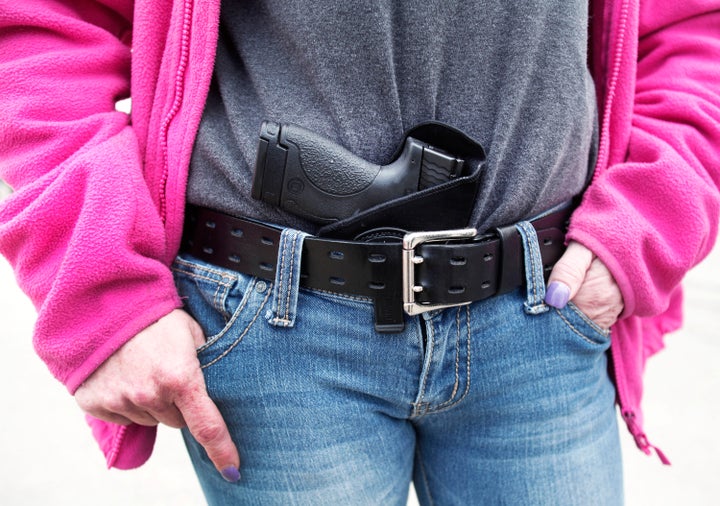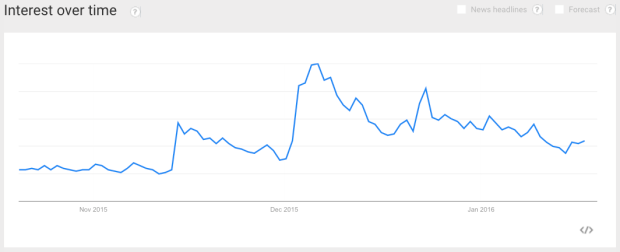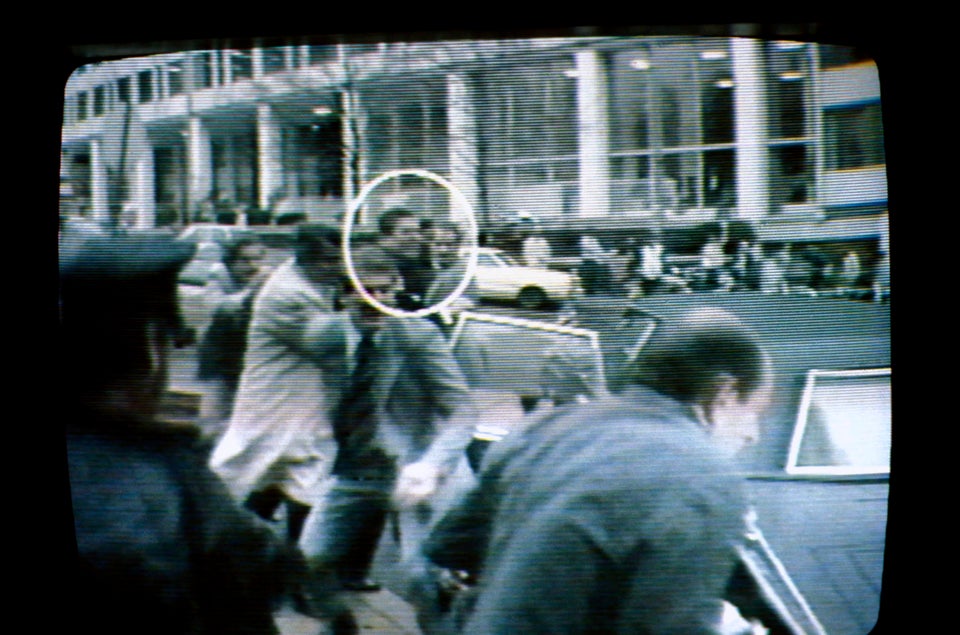Sheriffs across the country have a message to their constituents: If you have a gun, carry it—your country needs you.
In the aftermath of the terror attacks in Paris and San Bernardino, California, The Washington Post reports that county sheriffs across the United States are calling upon their citizens to serve as “the first line of defense” against crime. One sheriff in Wisconsin wants “as many law-abiding citizens to arm themselves in this country as we can get,” while another in Florida declared that “it’s more important to have a gun in your hand than a cop on the phone.” With American anxiety over terrorism as a top U.S. problem jumping from three percent to 16 percent in just one month since the Paris and San Bernardino tragedies, it’s not hard to understand why law enforcement authorities are looking to soothe feelings of helplessness among their constituents.
This call to arms among sheriffs isn’t the only display of force from individual Americans this year. Despite concerns among some gun owners, Texans celebrated their state’s new open carry status by flaunting assault rifles in several cities state-wide. The demonstrations came just a few weeks after gun rights advocates met to stage a “fake mass shooting” at the University of Texas–Austin. “Shooters are impolite and unpredictable,” Come and Take It founder told Fusion at the time. “Anyone can avoid a shooting they know is coming, but gun-free zones turn you into sitting ducks.” In an era where the U.S. seems engulfed in an epic of mass shootings, the message of gun rights advocates is clear: The only thing that stops a bad guy with a gun is a good guy with a gun.

In a political climate where federal gun control efforts are dead and the specter of Islamic terror seems more salient than ever, this message seems to be catching on. Research by gun advocate John Lott’s Crime Prevention Research Center suggests there were about 12.8 million concealed carry permit holders in the U.S. in 2015, up from 4.6 million in 2007, just before President Obama took office. In fact, after the 2012 Sandy Hook Elementary School massacre left 20 first-graders and six teachers dead, a majority of Americans favored protecting the rights of gun owners over gun control for the first time since the Pew Research Center started collecting data in 1993.
The Washington Post notes that U.S. interest in concealed weapons similarly jumped in the aftermath of the Paris and San Bernardino attacks:

But is there any empirical validity to this call to action? There have certainly been cases where an armed citizen—most often former law enforcement officers with extensive firearms experience—have come to the rescue in the event of a public shooting. But statistically, it’s more likely that someone with a concealed carry permit will set out to commit mass murder than prevent it.
Analysis by the Violence Policy Center has found that at least 29 mass shootings since 2007 were carried out by perpetrators with concealed carry permits. That’s more than three times the number of concealed permit holders who prevented mass shootings through their swift action. And it’s not as though those heroes (and they are heroes) are truly stemming the tide of non-sensical gun deaths in the U.S.: A Washington Post analysis of Federal Bureau of Investigation and Centers for Disease Control and Prevention data found that, for every “justifiable” gun homicide in 2012, there were 34 criminal gun homicides, 78 gun suicides, and at least two accidental gun deaths. Similarly, a 2014 study from the University of California–San Francisco found that people who owned a gun were three times as likely to kill themselves as non-firearm owners; by comparison, the annual per capita risk of death during a home invasion is 0.0000002 percent. Hell, even toddlers killed more people than terrorists in 2015. Guns are used far more often for killing than for self-defense, despite the fact that some 63 percent of Americans think guns make them safer.
A well-armed citizenry rarely makes an impact on mass shootings. According to 2014 FBI data, only seven of the 160 of the mass shootings that took place between 2000 and 2013 ended because of some would-be Rambo came to the rescue, according to the Huffington Post—but there was only one true exception (emphasis ours):
More than half (56 percent) were terminated by the shooter who either took his or her own life, simply stopped shooting or fled the scene. Another 26 percent ended in the traditional Hollywood-like fashion with the shooter and law enforcement personnel exchanging gunfire and in nearly all of those situations the shooter ended up either wounded or dead. In 13 percent of the shooting situations, the shooter was successfully disarmed and restrained by unarmed civilians, and in 3 percent of the incidents the shooter was confronted by armed civilians, of whom four were on-duty security guards and one person was just your average “good guy” who happened to be carrying a gun.
Even if armed civilians were to come to the rescue more often, there are questions as to how effective they’d be. Many instances where a “good guy with a gun” has put an end to a violent crime involve a good guy who’s actually a former law enforcement or security specialist, someone with a significant amount of training and discipline when it comes to moving thoughtfully and with purpose with a firearm. Not, in other words, an everyday civilian. In Ohio, for example, police arerequired to undergo 60 hours of training and additional coursework; New York City police officers go through a 13-day basic and tactical firearm training. But if, despite these training, incidents like the shooting death of 12-year-old Tamir Rice by a hot-headed officer in Cleveland persist, how can we expect that a responsible gun owner (without any mandatory training or rules of engagement) will perform like John Wayne under pressure?
Here’s the problem: An armed society is not necessarily a polite society, and an armed citizen is not always a prepared citizen. The promulgation of guns has made our society more jittery, more prone to accidental or emotional gun violence. This is embodied in Dan Baum’s piece for Harper’s, “Happiness is a Worn Gun,” published in 2010 before mass shooting exploded into a national epidemic. In his story, Baum—a self-described liberal Democrat who “got hooked on guns forty-nine years ago as a fat kid at summer camp”—gets himself a concealed carry permit. Apart from describing the matrix of politics and lifestyles that makes up the concealed carry movement, Baum details the psychological state of readiness that primes concealed carriers when they’re out in public:
In both classes, and in every book about concealed carry that I read, much was made of “conditions of readiness,” which are color-coded from white to red. Condition White is total oblivion to one’s surroundings—sleeping, being drunk or stoned, losing oneself in conversation while walking on city streets, texting while listening to an iPod. Condition Yellow is being aware of, and taking an interest in, one’s surroundings—essentially, the mental state we are encouraged to achieve when we are driving: keeping our eyes moving, checking the mirrors, being careful not to let the radio drown out the sounds around us. Condition Orange is being aware of a possible threat. Condition Red is responding to danger.
Contempt for Condition White unifies the gun-carrying community almost as much as does fealty to the Second Amendment. “When you’re in Condition White you’re a sheep,” one of my Boulder instructors told us. “You’re a victim.” The American Tactical Shooting Association says the only time to be in Condition White is “when in your own home, with the doors locked, the alarm system on, and your dog at your feet.... The instant you leave your home, you escalate one level, to Condition Yellow.” A citizen in Condition White is as useless as an unarmed citizen, not only a political cipher but a moral dud. “I feel I have a responsibility, and I believe that in my afterlife I will be judged,” one of the Boulder gun instructors said. “Part of the judgment will be: Did this guy look after himself? It’s a minimum responsibility.”
But if the data above is any indication, Condition Red is more of a red herring, awareness of one’s surroundings and readiness pushed to a logical extreme. Even police officers, who are ostensibly taught to de-escalate and avoid violent confrontation at their own costs, are now trained to react with extreme force regardless of the threat they’re faced with. This is the instinct, the “first rule of law enforcement” as University of South Carolina Professor Seth Stoughton puts it, that makes wearing blue a license to live in Condition Red: “Officers are trained to shoot before a threat is fully realized, to not wait until the last minute because the last minute may be too late.... American police officers are among the best-trained in the world, but what they’re trained to do is part of the problem.”
Underpinning the call by country sheriffs for an armed and vigilant citizenry (the latter of which is far from troubling) is the logic of the Second Amendment: that it’s every citizen’s right to bear arms in the context of a “well-regulated militia.” Perhaps it’s worth considering that what once passed for a well-regulated militia in the aftermath of the American Revolution—guerilla soldiers with inaccurate firearms—makes little sense in an era of the assault rifle, despite the existential threat of terrorism or crime. Calling on Americans to live in Condition Yellow rather than the complacency of Condition White, to say something when they see something, is important and valid, as is further educating “responsible” gun owners as we would police officers so they can truly be responsible. But in the end, the average citizen with a Glock and 10 hours on a shooting range can be more of a danger to himself and the community he set out to protect than any terrorist, foreign or domestic.
This story was originally published by Pacific Standard. An earlier version of the story said the shootings at Sandy Hook Elementary School left 20 sixth-graders dead; in fact, the victims were first-graders.
